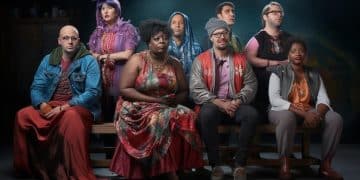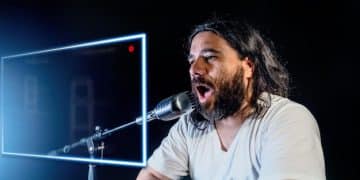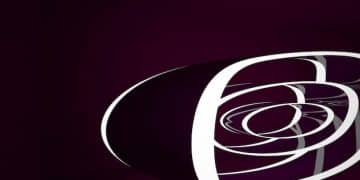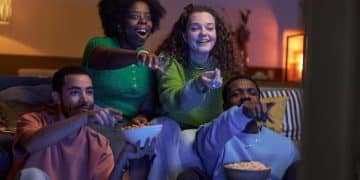The Rise of the Anti-Hero: Examining Morality in Modern Series
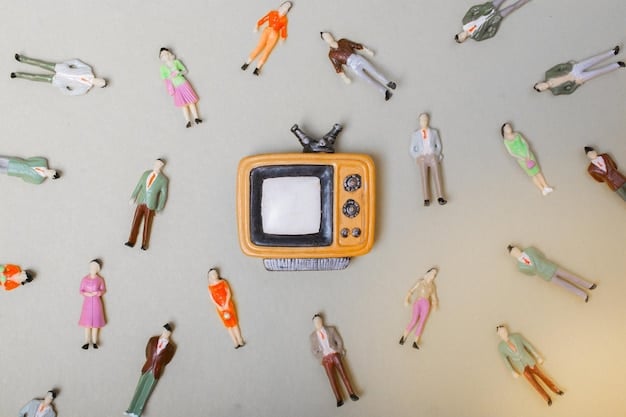
The emergence of the anti-hero in modern series challenges traditional notions of morality, inviting viewers to explore complex characters whose questionable actions often serve ambiguous or self-serving ends, pushing the boundaries of what defines a protagonist.
In recent years, the landscape of television and film has undergone a significant transformation. Gone are the days when protagonists were unequivocally good, always standing as paragons of virtue. Instead, we’ve witnessed the pervasive rise of the anti-hero: examining morality in modern series through a more nuanced, often dark, lens. These complex characters defy easy categorization, forcing us to re-evaluate our understanding of heroism and the very nature of good and evil.
The Shifting Sands of Heroism: A Historical Perspective
For centuries, storytelling has relied on a clear delineation between heroes and villains. From ancient myths to classic literature, protagonists embodied noble ideals, while antagonists represented pure evil. This dichotomy provided a comforting moral framework, guiding audiences through narratives where right and wrong were easily distinguishable. However, as societies evolved and became more complex, so too did our narratives.
The 20th century saw the subtle introduction of characters who blurred these lines, but it was in the late 20th and early 21st centuries that the anti-hero truly began to dominate the screen. This shift can be attributed to a growing skepticism towards authority and a desire for more realistic, less idealized portrayals of human nature. Viewers, tired of predictable heroes, craved characters who reflected the messiness and moral ambiguities of real life.
From Flawed Heroes to Anti-Heroes
While flawed heroes have always existed, the anti-hero takes this concept much further. A flawed hero might make mistakes or have personal struggles, but their core intentions remain good. An anti-hero, conversely, often operates outside traditional moral codes, driven by self-interest, vengeance, or a distorted sense of justice.
- Intent vs. Outcome: Anti-heroes often achieve positive outcomes through morally dubious means.
- Personal Motivations: Their actions are frequently driven by deeply personal, rather than altruistic, goals.
- Audience Empathy: Despite their flaws, audiences often find themselves empathizing with their struggles and motivations.
This evolution reflects a broader cultural introspection, where the simplistic narratives of yesteryear no longer fully resonate. Audiences are now more sophisticated, seeking stories that challenge their perspectives and engage with the complexities of the human psyche.
The transition from clear-cut heroes to these morally ambiguous figures marks a significant turning point in narrative history. It suggests a maturation of storytelling, moving beyond the binary of good versus evil to explore the vast, often unsettling, grey areas in between.
Deconstructing the Archetype: What Defines an Anti-Hero?
Defining an anti-hero isn’t as straightforward as one might think, as the archetype encompasses a broad spectrum of characters. They are not necessarily villains, yet they rarely fit the traditional mold of a hero. Their defining characteristics often revolve around their relationship with conventional morality and their motivations.
The core of an anti-hero lies in their internal conflict and external actions which, while sometimes leading to a desirable outcome, are often achieved through questionable, unethical, or even illegal means. This creates a compelling tension for the viewer, who is forced to reconcile the character’s appeal with their reprehensible behavior.
Key Characteristics of the Anti-Hero
Several traits commonly distinguish anti-heroes from other character types. Understanding these characteristics helps to illuminate why these figures resonate so strongly with contemporary audiences.
- Moral Ambiguity: Their actions cannot be simply labeled as “good” or “evil.” They inhabit a moral grey zone.
- Self-Interest: While their actions may benefit others, their primary motivation is often self-preservation, gain, or personal vengeance.
- Rejection of Norms: They frequently operate outside societal rules, laws, or ethical boundaries.
Furthermore, anti-heroes often possess a cynical worldview, a disinterest in conventional heroism, and a willingness to break rules that traditional heroes would uphold. This makes them unpredictable and often more relatable, as their struggles mirror the imperfections of real people.
The ability of an anti-hero to elicit both fascination and discomfort is what makes them such powerful narrative tools. They challenge us to look beyond simplistic judgments and consider the complex web of motivations that drive human behavior.

Why Now? The Cultural Resonance of Anti-Heroes in Modern Society
The proliferation of anti-heroes in modern series isn’t merely a narrative trend; it reflects deeper shifts in contemporary cultural attitudes. Our society has grown increasingly skeptical of institutions, authority figures, and simplistic narratives, creating fertile ground for characters who embody this disillusionment.
In a world grappling with complex global issues, political polarization, and a constant barrage of information, the clear moral compass found in traditional heroes often feels naive or unrealistic. Anti-heroes, with their nuanced struggles and often cynical outlooks, resonate more deeply with an audience that recognizes the shades of grey in their own lives.
Mirroring Societal Disillusionment
The rise of the anti-hero can be seen as a mirror reflecting a society that has become wary of overt heroism. After decades of global conflicts, economic downturns, and increasing social inequalities, the public’s trust in established systems has wavered. Anti-heroes often embody the frustration and cynicism born from this disillusionment.
- Skepticism of Power: Anti-heroes frequently challenge corrupt systems or powerful institutions.
- Flawed Reality: They present a more “realistic” portrayal of leadership and decision-making, where perfect solutions are rare.
- Viewer Catharsis: Their unconventional methods can provide a cathartic release for viewers feeling powerless in their own lives.
Moreover, the increased complexity of storytelling facilitated by streaming services and longer narrative arcs allows for more in-depth character development. This enables creators to explore the multifaceted personalities of anti-heroes, delving into their past traumas, motivations, and the circumstances that shaped their moral compass.
This cultural resonance suggests that anti-heroes are not just entertaining; they serve as a reflection of our collective anxieties and perhaps, a yearning for honesty in storytelling, even if that honesty reveals uncomfortable truths about human nature.
The Psychological Allure: Empathizing with the Morally Grey
One of the most fascinating aspects of the anti-hero phenomenon is our psychological inclination to empathize with characters who perform morally questionable acts. This isn’t about condoning their behavior, but rather understanding the complex motivations that drive it. It challenges us to look beyond actions and delve into the human condition.
Modern series excel at granting us intimate access to the inner lives of these characters, revealing their vulnerabilities, regrets, and the deep-seated fears that often fuel their darker impulses. This narrative technique fosters a profound sense of empathy, even for characters engaged in truly reprehensible acts.
Unpacking Viewer Identification
Why do we cheer for Walter White? Why do we root for Tony Soprano? The answer lies in the masterful way these characters are written, making them relatable despite their villainous tendencies. We often see echoes of our own struggles, desires, and frustrations in their journeys, albeit amplified to dramatic proportions.
- Relatable Flaws: Their imperfections make them feel more human and less idealized.
- Underlying Humanity: Despite their cruelty, glimpses of their humanity – their love for family, moments of kindness – keep us invested.
- Complex Motivations: Their actions are rarely purely evil; they often stem from understandable, albeit twisted, motivations.
The psychological allure also stems from a vicarious thrill. Anti-heroes often transgress boundaries we, as law-abiding citizens, would never cross. Experiencing these transgressions through a character provides a safe outlet for exploring forbidden desires or challenging societal norms without real-world consequences.
This deep dive into the psyche of the anti-hero forces us to confront uncomfortable questions about our own moral boundaries and the capacity for both good and evil that resides within us all. It’s a testament to the power of compelling storytelling that these characters can evoke such a complicated mix of revulsion and admiration.
Case Studies in Moral Ambiguity: Iconic Anti-Heroes
To truly grasp the impact of the anti-hero, it’s essential to examine specific examples that have redefined television. These characters, through their complex narratives and often shocking actions, have become cultural touchstones, sparking endless debates about morality and storytelling.
From drug kingpins to conflicted detectives, these archetypes populate our screens, each offering a unique exploration of what happens when traditional heroism is discarded in favor of raw, often brutal, self-interest or a twisted sense of justice. Their stories are not just entertaining; they are profound commentaries on the human condition.
Breaking Bad’s Walter White: The Accidental Criminal
Perhaps no character embodies the anti-hero archetype more completely than Walter White from Breaking Bad. A meek chemistry teacher diagnosed with terminal cancer, Walter’s initial foray into drug manufacturing is driven by a desire to secure his family’s financial future. However, this seemingly noble intention spirals into a relentless pursuit of power, transforming him into the ruthless drug lord, Heisenberg.
- Transformation Arc: Witnessing his gradual descent into darkness is both terrifying and compelling.
- Justification of Evil: His actions are often “justified” by his family’s needs, creating a complex moral dilemma for the audience.
- Audience Complicity: Viewers are often caught between rooting for his success and condemning his methods.
Walter’s journey forces us to confront the thin line between desperation and depravity, illustrating how seemingly good intentions can pave the way to hell.
The Sopranos’ Tony Soprano: The Mob Boss in Therapy
Tony Soprano, the titular character of The Sopranos, presented audiences with an unprecedented look inside the mind of a mob boss. Struggling with panic attacks, Tony seeks therapy, offering a unique juxtaposition of his brutal professional life with his vulnerable personal struggles. He is a loving father and husband, yet a violent, ruthless criminal.
- Domestic vs. Criminal Life: The stark contrast between his roles highlights his moral contradictions.
- Psychological Depth: His therapy sessions reveal deep-seated issues that humanize his darker side.
- Ethical Dilemmas: Viewers are constantly torn between condemning his actions and empathizing with his struggles.
Tony Soprano redefined protagonist portrayal, proving that anti-heroes could be deeply flawed, yet endlessly fascinating, ushering in a new era of complex television narratives.
Dexter’s Dexter Morgan: The Vigilante Serial Killer
Dexter Morgan, from the series Dexter, is a forensic blood spatter analyst for the Miami Police Department who, in his spare time, moonlights as a serial killer targeting other murderers who have escaped justice. He operates under a strict “code” to only kill those who truly deserve it, making him a complex figure of vigilante justice.
- “Good” Intentions: His victims are always criminals, creating a moral loophole for the audience.
- Internal Monologue: His inner thoughts provide a chilling, yet insightful, perspective on his actions.
- Ethical Boundaries: He constantly pushes the audience to question if the “ends justify the means.”
These characters, among many others, have cemented the anti-hero’s place in modern storytelling, pushing the boundaries of morality and inviting audiences into narratives that are as disturbing as they are engaging.
The Impact on Storytelling and Future Narratives
The rise of the anti-hero has profoundly reshaped the landscape of storytelling, influencing not only character development but also plot structures, thematic explorations, and audience engagement. This shift signals a maturation in how we consume and create narratives, moving away from simplistic good-versus-evil tales.
This enduring fascination with morally ambiguous characters has opened doors for more audacious and thought-provoking content. It has encouraged writers and producers to experiment with darker themes, intricate character psychology, and narratives that don’t offer easy answers.
Redefining Protagonist Development
One of the most significant impacts is on the very definition of a protagonist. No longer does a character need to be inherently “good” to lead a series. This allows for a wider range of stories to be told, focusing on individual struggles, human fallibility, and the often messy pursuit of goals, regardless of their moral standing.
- Complex Arcs: Characters can undergo profound transformations, both positive and negative.
- Relatability: Flawed characters often feel more human and accessible to audiences.
- Audience Investment: The dramatic tension from moral dilemmas keeps viewers captivated.
The anti-hero has also paved the way for more nuanced portrayals of secondary characters and antagonists. As the protagonist becomes morally ambiguous, the line between hero and villain blurs, allowing for a more sophisticated exploration of character dynamics and motivations across the board.
Ultimately, the anti-hero has demonstrated that audiences are ready for, and even crave, narratives that challenge their perceptions and refuse to provide clear-cut moral frameworks. This promises a future of storytelling that is richer, deeper, and more reflective of the complexities of the human experience.

The Limitations and Criticisms of the Anti-Hero Trend
While the anti-hero trend has brought immense depth and complexity to modern narratives, it is not without its limitations and criticisms. Some argue that the overreliance on these characters can lead to narrative staleness, moral fatigue, or even a subtle normalization of negative behaviors.
The constant exposure to characters who flout moral conventions, even if their actions are dramatically justified, can desensitize audiences to the gravity of their transgressions. It raises questions about the ethical responsibilities of storytellers and the potential influence these narratives have on societal values.
Are We Glorifying Immorality?
A primary criticism is the concern that anti-hero narratives, despite their nuanced portrayals, inadvertently glorify or romanticize immoral behavior. When audiences consistently empathize with characters who lie, cheat, or kill, there’s a risk of blurring the lines between fictional entertainment and real-world ethical implications.
- Desensitization: Repeated exposure to violence and unethical acts can lessen their impact.
- Reduced Stakes: If everyone is morally grey, where do the true stakes lie?
- Lack of Role Models: Some argue that an absence of clear heroes removes positive role models from entertainment.
Furthermore, the sheer volume of anti-hero narratives can lead to a sense of predictability. Once a trend becomes dominant, it risks becoming a formula, stripping away its initial revolutionary appeal. Viewers might begin to anticipate the “bad decision” or the “moral compromise,” diminishing the dramatic impact.
Balancing compelling character development with moral responsibility remains a challenge for creators. While the anti-hero offers a rich vein for dramatic exploration, an over-saturation or uncritical embrace of the archetype could, ironically, limit the very narrative innovation it once championed.
| Key Aspect | Brief Description |
|---|---|
| 🎭 Moral Ambiguity | Anti-heroes defy easy good/evil labels, exploring complex moral grey areas. |
| 🧠 Psychological Depth | Viewers delve into their complex motivations, fostering unexpected empathy. |
| 🔄 Cultural Reflection | Their popularity mirrors societal skepticism and a desire for realistic portrayals. |
| 📚 Narrative Evolution | Anti-heroes allow for richer, less formulaic storytelling and character arcs. |
Frequently Asked Questions About Anti-Heroes
▼
While both anti-heroes and villains may perform morally questionable acts, a key distinction lies in their motivations and audience perception. Villains are typically driven by malevolent goals or pure self-interest that harms others. An anti-hero, however, often possesses some redeeming qualities or a relatable, albeit flawed, rationale for their actions, leading viewers to empathize with them despite their unethical choices.
▼
Their popularity stems from several factors. Audiences are increasingly seeking more complex, realistic characters that reflect societal nuances and skepticism towards idealized heroism. Anti-heroes offer a cathartic outlet for exploring difficult moral questions and societal flaws without simplistic answers. The extended narrative formats of modern series also allow for deeper character development, making these morally ambiguous figures incredibly compelling.
▼
Not necessarily. While many anti-heroes face tragic consequences for their actions, reflecting the theme that “crime doesn’t pay” or that dark paths lead to ruin, others might achieve their goals and even find a form of redemption or peace. The ending for an anti-hero often serves to conclude their complex journey, which can vary from devastating to surprisingly satisfying, depending on the narrative’s message.
▼
Anti-heroes disrupt the traditional hero’s journey where protagonists are inherently good and strive for noble ends. They introduce moral ambiguity, forcing audiences to question right and wrong. This prompts more sophisticated plotting, as their actions don’t always align with conventional morality, leading to unpredictable outcomes and deeper thematic explorations. It allows for tales that delve into the greyer areas of human psychology.
▼
Generally, anti-heroes are not presented as positive role models in the traditional sense, as their methods are often unethical or harmful. However, they can serve as figures through whom audiences can explore complex moral dilemmas and the consequences of certain choices. They might inspire critical thinking about justice, power, and human flaws, rather than offering straightforward examples of virtuous behavior. Their value lies in sparking discussion, not emulation.
Conclusion
The anti-hero has unequivocally carved out a definitive space in modern series, transforming how we perceive protagonists and morality in storytelling. These multifaceted characters challenge our preconceived notions of good and evil, inviting us into a world of moral ambiguity, where heroes are not always heroic and motivations are rarely pure. Their enduring appeal speaks volumes about our contemporary desire for narratives that reflect the complex, often messy, reality of the human condition. As storytellers continue to explore the depths of human behavior, the anti-hero, with all their flaws and contradictions, will undoubtedly remain a central figure in our entertainment landscape, prompting us to perpetually examine where morality truly lies.
